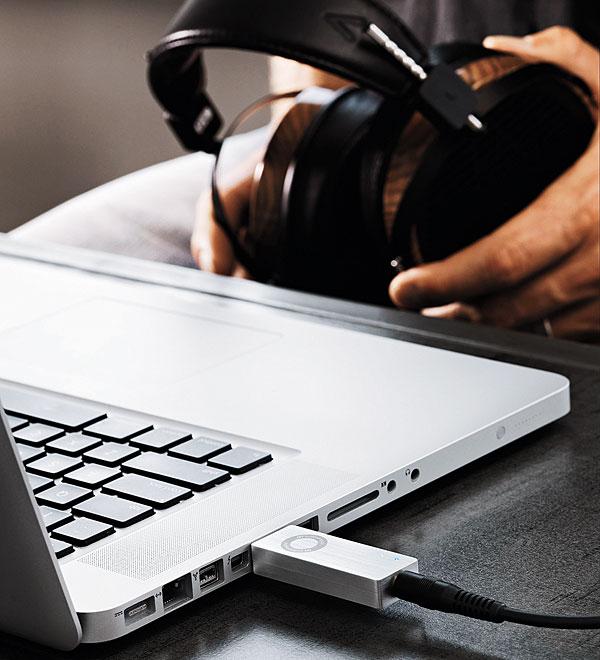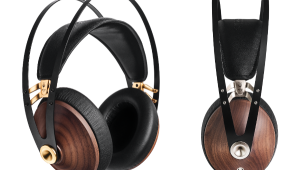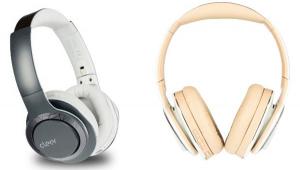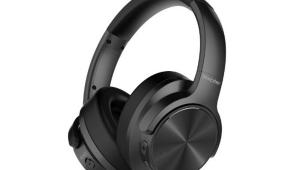Supercharge Your Headphones: 3 DAC/Headphone Amps Put to the Test

The catch is that, like many of the best headphones, the Sennheiser requires high-quality amplification to work its magic. Having just bought an HD600, I was ready for the next step in my development as a headphone listener: a headphone amp.
Your smartphone or iPod may well be able to run a pair of high-end headphones, but whether it runs them well is another matter. The flea-sized amp built into a mobile device typically conjures thin, grainy, dynamically constrained sound, especially when forced to run near the top of its volume range. An external headphone amp provides cleaner power and more of it, producing strain-free sound at higher volumes. It transforms the performance of your headphones, enabling you to get every bit of the great sound in which you invested.
Choosing the Right Headphone Amp
Buying a headphone amp requires a few decisions. Would you prefer a solid-state amp or a vacuum-tube one? To help get you on the path to discovery, I rounded up DAC headphone amplifers at three price levels and put them to the test: the Audioengine D3 USB model ($189), the NAD D 1050 ($499), and the Essence HDACC ($699). All are solid state. Tube amps often sound warmer, but their performance mutates over time, and the tubes need to be replaced once in a great while. For “tube rolling” enthusiasts, that’s creative opportunity. However, this headphone-amp roundup will play it safe and stick with solid-state designs.
Another decision: Would you like your amp with or without DAC? Having a built-in, high-performance digital-to-analog converter is more convenient, especially if much of your music is coming out of a computer’s USB jack. But you might prefer to consider the DAC (and its sound) as a separate purchase, mating it to the amp to better optimize the sound—the computer audiophile’s equivalent of tube rolling. All of the amps reviewed here have built-in DACs and are compatible with both Windows and Mac.
Having decided to buy a DAC with your headphone amp, you are also buying into its file-type compatibilities or lack thereof. All of the products in this roundup are compatible with PCM audio (but not DSD) up to 24 bits. Their handling of sampling rates varies. All three DACs accept files up to 192 kHz, though the Audioengine downsamples or upsamples all compatible files to its native 96-kHz rate and pads all sample sizes to 24 bit, regardless of their native depth.
The more expensive NAD and Essence DACs process up to native 192-kHz files without conversion. The NAD plays all files bit-for-bit, with no up- or downsampling, while the Essence gives you the option of converting files. Critically, all the DACs operate in asynchronous mode, taking over the clocking function from your computer and stabilizing it to maximize sound quality and prevent glitches.
Last, a key consideration in headphones and headphone amps is impedance matching. Higher-impedance ’phones need more voltage to drive, more likely available from a good outboard amp. Lower-impedance models require greater current to drive, easier for the internal amp in a portable device to deliver, but still good candidates to use with most amps. Each amp reviewed here specifies a range of acceptable headphone impedances. You’ll want to make sure your ’phones fall within that range.
The Test
The headphones I used for this roundup vary in impedance and price. The model with the highest impedance, thus demanding the most voltage, is Sennheiser’s HD600 ($400) with an impedance of 300 ohms. Sony’s MDR-V6 ($110)—the consumer-level version of the MDR7506 studio headphones ($130)—and Audeze’s LCD-X ($1,699, an open-back version of the recently reviewed LCD-XC) have impedances of 63 and 22 ohms, respectively. In practice, all three amps drove all three ’phones to satisfactory levels (and then some), though the Sennheiser required higher volume settings. Incidentally, in the listening notes, I may be in danger of reviewing the headphones as much as the amps—but exploring how the amps deal with different ’phones makes it worth the risk.
Other associated equipment included a Lenovo ThinkCentre M75 desktop PC running Windows 7, Foobar 2000 for playing FLACs, and Windows Media Player for other file formats, the latter including support for Apple Lossless via the DC-Bass Source Filter.
The Demo Material
My freewheeling, unstructured listening aside, I used the following test tracks with all three amps and all three headphones, and they received the most attention. Many thanks to HDtracks for providing the FLAC files.
- Beethoven’s Symphony No. 5, first movement, Carlos Kleiber conducting the Vienna Philharmonic, FLAC, 88.2-kHz/24-bit
- Tchaikovsky, “Waltz of the Flowers,” The Nutcracker Suite, Bernhard Klee conducting the Bruckner Orchester Linz, FLAC, 96/24
- Scriabin, Piano Sonata No. 10, Scriabin Sonatas, Igor Zhukov, 16-bit ALAC ripped from CD
- Led Zeppelin, “No Quarter,” Celebration Day, 16-bit ALAC ripped from CD
- The Beatles, “Norwegian Wood,” Rubber Soul, 16-bit ALAC ripped from CD
- Bob Marley & the Wailers, “Is This Love,” Kaya, FLAC, 96/24
- Nataly Dawn, title track, How I Knew Her, FLAC, 88.2/24
- Otis Redding, title track, The Dock of the Bay, FLAC, 96/24.
Which DAC/headphone amp combo did I like best? See the following reports for detailed results of my listening tests:
- Log in or register to post comments




































































